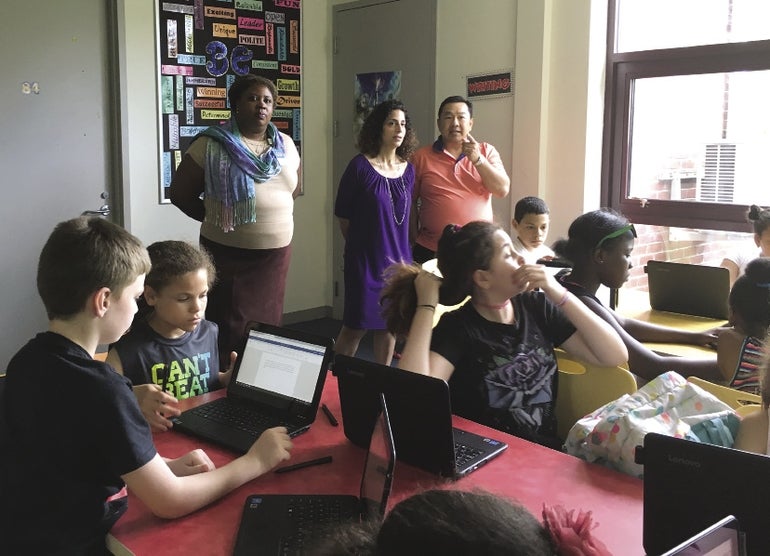To Liz Hamilton, executive director of the Boys & Girls Club of Worcester, it’s hard to overstate the importance of encouraging club members to learn about science and technology.
“Tech jobs are the fastest-growing segment of the economy, but kids like our members are being left behind,” Hamilton said.
With 80 percent of the club’s children living below the poverty line, and many of them attending schools lacking up-to-date labs and computer equipment, it can be hard for them to get access to the kinds of hands-on experience to build confidence and enthusiasm.
So Hamilton was thrilled to partner with Washington tech giant Microsoft on a pilot program this spring to introduce dozens of club members ages 10 to 17 to computer tools for learning about science, technology, engineering, art and mathematics, or STEAM.
The company provided the club with tablet computers, curricular materials and training for staff. Students used software including Sway, a multimedia storytelling program, and Immersive Reader, an interactive learning tool, to work on projects of interest to them. They also used Minecraft, which the program offered as an incentive and an opportunity to think creatively.
Tisha Nguyen, the Microsoft solutions professional for New England, worked with club on the effort. She said the program, called the Accessibility and STEM Device Pilot, was one of many pilot programs the company runs around the country, each designed to cater to the needs of a particular group.
“The Boys & Girls Club serves a wide range of students and kids with different learning styles and skillsets,” Nguyen said. “Since Microsoft’s tools are geared toward accessibility and learning, this was a great fit and partnership.”
High interest & engagement
Nguyen said the software was chosen to whet students’ interest in science and technology. Hamilton said it was easy to see how well it succeeded.
“As the program progressed, the kids started coming in eager to work,” Hamilton said. “They even did extra credit work out of interest: One 8th grader took it upon himself to present a project to the public school superintendent and others, when they were here observing.”
The program was designed to accommodate 30 kids in two sessions per week, but the club ended up expanding its use of the program, running it every day and encouraging children to take on their own projects after finishing each day’s assignment. Not every student attended every day, so staff were able to include 60 kids, rather than the 30 they had initially planned on. The club was careful to include kids from a range of ages, with different academic strengths and weaknesses, including some with dyslexia or other learning difficulties.
“Demand increased as the program went along,” Hamilton said.
Meeting industry needs
The idea of STEAM comes from an extension of the common acronym STEM to include the arts.
“Many club kids think the hard sciences and mathematics are too difficult to attempt,” Hamilton said. “Most often, they prefer to not try, rather than lose face in effort they believe is doomed to failure. The A in STEAM, art, provides a way in. It acts as a lever to open up the other fields for our kids, by bringing in creativity, innovation, and – especially – the sense that they can’t get it wrong.”
Nguyen said she helped create an action plan at the start of the program and checked in over the following weeks to see if kids were meeting the goals. Local executives and community leaders observed the pilot and gave positive feedback. In the end, Nguyen said, students were able to use the things they’d learned to pursue their own goals, including doing school homework assignments and pursuing questions.
“Because of that, I think the program was very successful,” she said.
Preparing students for careers in science and technology fields has been a long-term focus for many educators and business leaders in Central Massachusetts. Kathie Mahoney, marketing and administration director for the Massachusetts Manufacturing Extension Partnership in Worcester, said local manufacturers are eager for students to learn about current careers in the industry, which often require more technical skills than in the past.
“It’s a great opportunity to increase awareness about the opportunities available within manufacturing,” Mahoney said. “Manufacturing is such a vital part of the Worcester economy and the Central Massachusetts economy.”
The Boys & Girls Club already has a number of longstanding partnerships around STEM and STEAM with other local institutions including Becker College and Worcester Polytechnic Institute. For the last few years, Hamilton said, multinational manufacturer Saint-Gobain, which has operations around Greater Worcester, has been sponsoring its STEM curricula.
This summer, the club plans to expand on the Microsoft pilot program, offering 200 kids the chance to take part. And Hamilton said it’s continuing to extend its partnerships with the area’s business community.
“Moving forward, we will be meeting with tech leaders and corporations in the area, sharing with them the impact our programs have already had on our kids, and inviting them to be a partner in our efforts,” she said.

